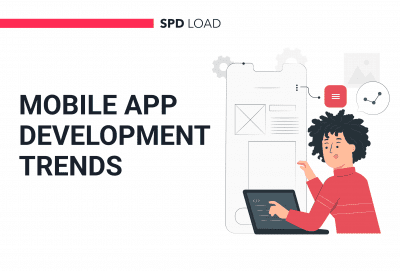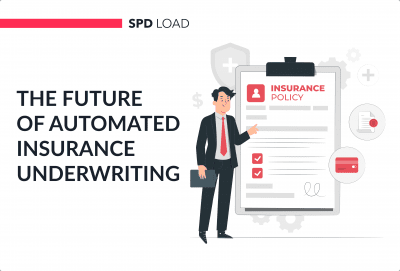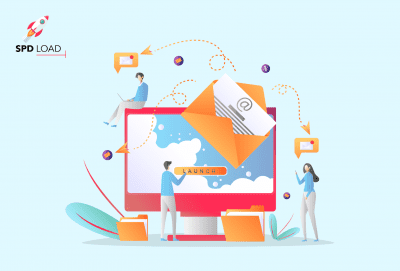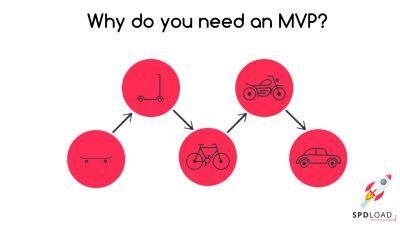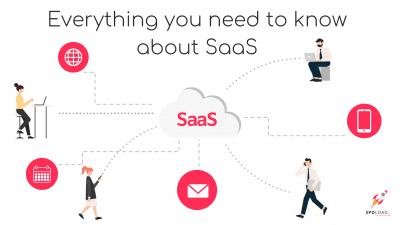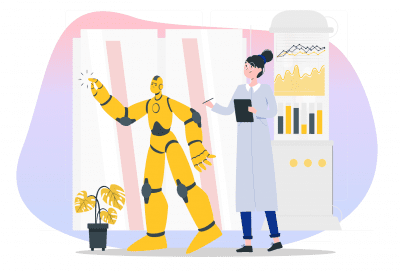Performance Management Systems: What are They & How to Choose One
- Created: May 05, 2025
- 12 min
Organizations and teams have finally started to realize the benefits of investing in their people and culture.
Gallup workplace report states that businesses with highly engaged employees experience 23% higher profitability and 18% higher productivity compared to those with disengaged employees.
In particular, regular constructive feedback and goal alignment act as critical drivers of engagement.
Traditional performance management systems rely on annual reviews and rigid evaluations to assess employee performance.
They often fail because they provide infrequent feedback, focus too much on past performance rather than growth, and create stress instead of motivation.
In this article, we explore what effective performance management systems are and how they work and share some tips on choosing the best one or.
And if you are looking to hire dedicated app developers for your HR software project, feel free to explore our services.
Let's shape your startup's product vision together!
What is a Performance Management System?
Simply put, a performance management system is a way of tracking how well employees are doing their jobs.
It uses a mix of technologies and methods to make sure everyone in the company is working towards the company’s main goals.
It is a way for managers and employees to work together. They can set performance expectations, set goals for employees, decide how to measure performance and share reviews and feedback.
When properly defined and consistently applied, a performance management system can make the workforce more productive.
Employees care more about their work and less about leaving, and the money made per employee goes up.
Performance management software can be set up in different ways, including on your own computer, in the cloud, or a mix of both.
Key Elements of a Performance Management System
Each performance management program consists of three key elements:
- Performance review and evaluation
- Goal setting
- Feedback and coaching
Let’s explore them in more detail.
Performance review and evaluation
Team performance review and evaluation is basically an assessment of an employee’s performance against predefined goals, competencies, and expectations.
It is often conducted periodically (e.g., quarterly, biannually, or annually).
The main features of this performance management element include:
- objective assessment (performance is evaluated based on measurable criteria, like key performance indicators, objectives and key results)
- 360-degree feedback (constructive feedback from peers, managers, subordinates, and sometimes even customers to provide a holistic view of performance)
- formal documentation (records performance outcomes to track progress over time and inform decisions about promotions, rewards, or development needs)
Goal setting
Goal setting is when you define clear, measurable, and achievable objectives for employees. These goals must align with the strategic priorities of your organization.
Key features of this performance management element are SMART goals (Specific, Measurable, Achievable, Relevant, and Time-bound), alignment with organizational goals, and a collaborative process.
Using this probative approach, employees gain a sense of purpose and direction as well as motivation.
Feedback and coaching
Feedback and coaching are ongoing processes that involve providing employees with constructive input on their performance and guiding them to improve.
Feedback should be timely and delivered regularly (not just during formal reviews) to address issues and reinforce positive behaviors.
It is also vital to enhance two-way communication as a dialogue between managers and employees encourages progress, challenges, and solutions.
Feedback also has to be development-oriented and focused on helping employees grow their skills and capabilities through coaching, mentoring, and training. 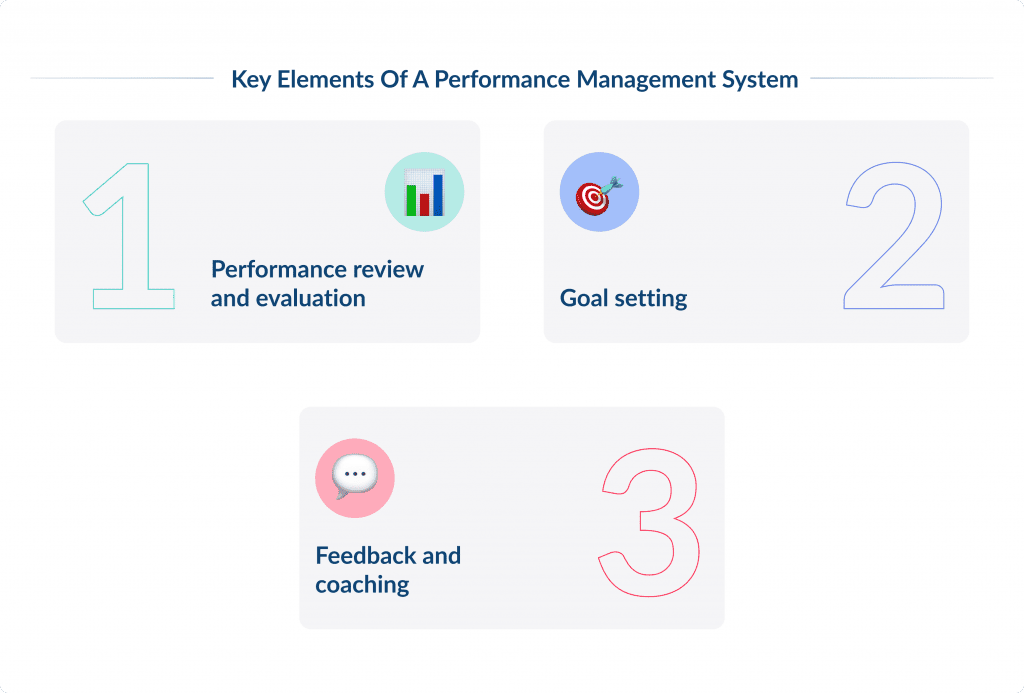
Importance of Performance Management
The goal of performance management is to empower employees to perform at their best, align their efforts with the organization’s strategic objectives, and create a positive and fulfilling work environment for everyone.
On top of that, performance management aims to develop the skills and competencies employees need to improve performance and success in their jobs. In turn, these skills help the organization meet its goals.
However, many companies fail to monitor and manage this process.
In fact, a Betterworks study reported that 21% of employees say their goals are set annually and never looked at again.
16% of the respondents say they do not set any goals at work.
A third of employees reported that they don’t have one-to-ones with managers or receive feedback to help them work towards goals more than twice a year. And every 1 in 10 employees claims they rarely or never receive this type of feedback. 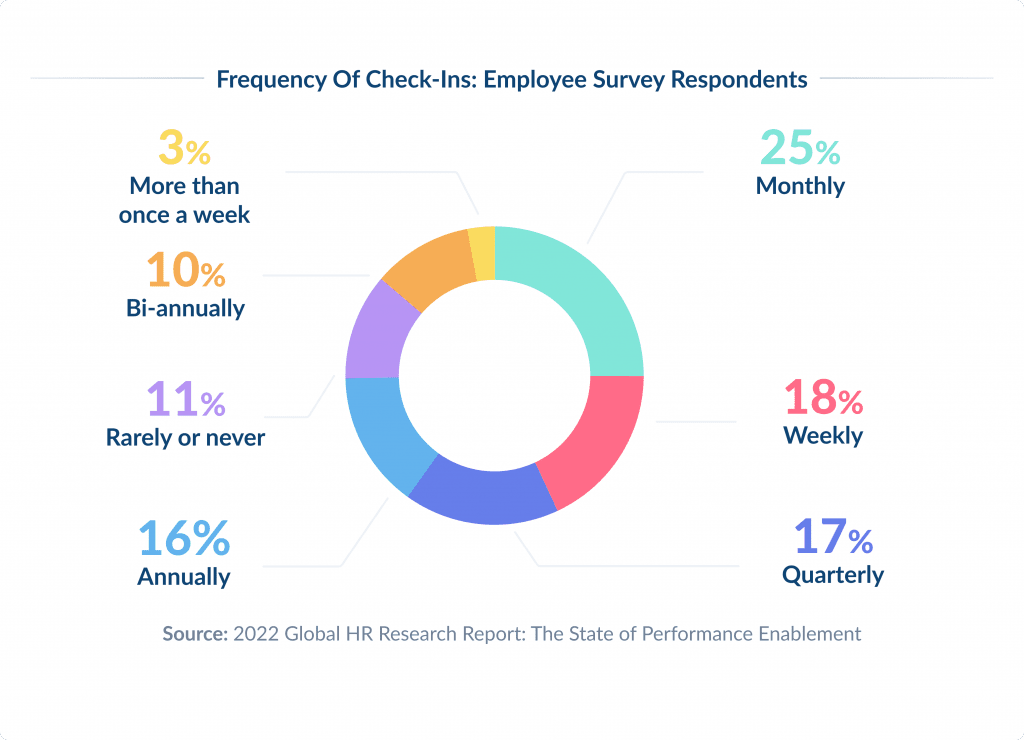
The important thing to know here is that most people are not happy with the current processes and tools. It’s not surprising that only 39% of employees say that current check-ins are working well for them.
What needs to be done to make these check-ins better?
One good change for companies to make is to improve their performance management process and focus more on goals and growth.
Let’s dive deeper into this point.
Stages of the Performance Management Process
Just like it goes with employee wellness programs, performance management is a step-by-step process.
It helps employees do their best and makes sure that what they do matches organizational objectives.
This is a continuous and adaptable approach that focuses on employee development, not just yearly reviews.
There are usually five important stages in this cycle: planning, monitoring, developing, rating &reviewing, and rewarding.
Here, we break down each step of the performance management cycle.
Planning: Clear Goals And Expectations
The performance management process starts with a plan.
Employees and managers sit down to discuss expectations, set goals, and outline what success looks like.
These goals should be clear, realistic, and meaningful — something employees can work toward with confidence.
It’s also a chance to make sure individual goals align with the company’s bigger picture so everyone is working toward the same vision.
Monitoring: Continuous Performance Management
Instead of waiting until the end of the year to talk about performance, you want to introduce regular check-ins to keep things on track.
These can be quick chats, monthly meetings, or real-time feedback whenever needed. Anything that works for you and helps ensure continuous improvement.
The idea is to catch any roadblocks early, make adjustments if necessary, and monitor if employees have the support they need to do their best work.
Developing: Encouraging Employee Engagement
Performance management is not solely dictated by measuring results. It is also about helping people improve.
This stage focuses on coaching, mentorship, training, and opportunities to take on new challenges.
Whether it’s a leadership workshop, a new project, or just helpful guidance from a manager, this step is critical for employees to feel supported in their personal and professional growth.
Rating & Reviewing: Constructive And Ongoing Feedback
Formal reviews happen periodically (quarterly, biannually, or annually), but they shouldn’t be a stressful one-way evaluation.
Instead, there should be open conversations where employees and managers discuss achievements, challenges, and areas to improve.
The best feedback is clear, constructive, and focused on helping employees succeed rather than just pointing out mistakes.
Rewarding: Steps To Career Development
Feeling valued is a huge motivator.
Recognizing employees for their contributions — whether through raises, promotions, bonuses, or even a simple “great job” — goes a long way in keeping morale high.
People who feel appreciated are more engaged, more productive, and more likely to stay with the company.
LinkedIn Workplace Learning Report (2023) highlights that employees who feel their performance is managed effectively are 3x more likely to stay with their organization.
Additionally, 94% of employees say they would stay longer at a company that invests in their development.
You can use employee recognition programs to reward and acknowledge the great job your employees do.
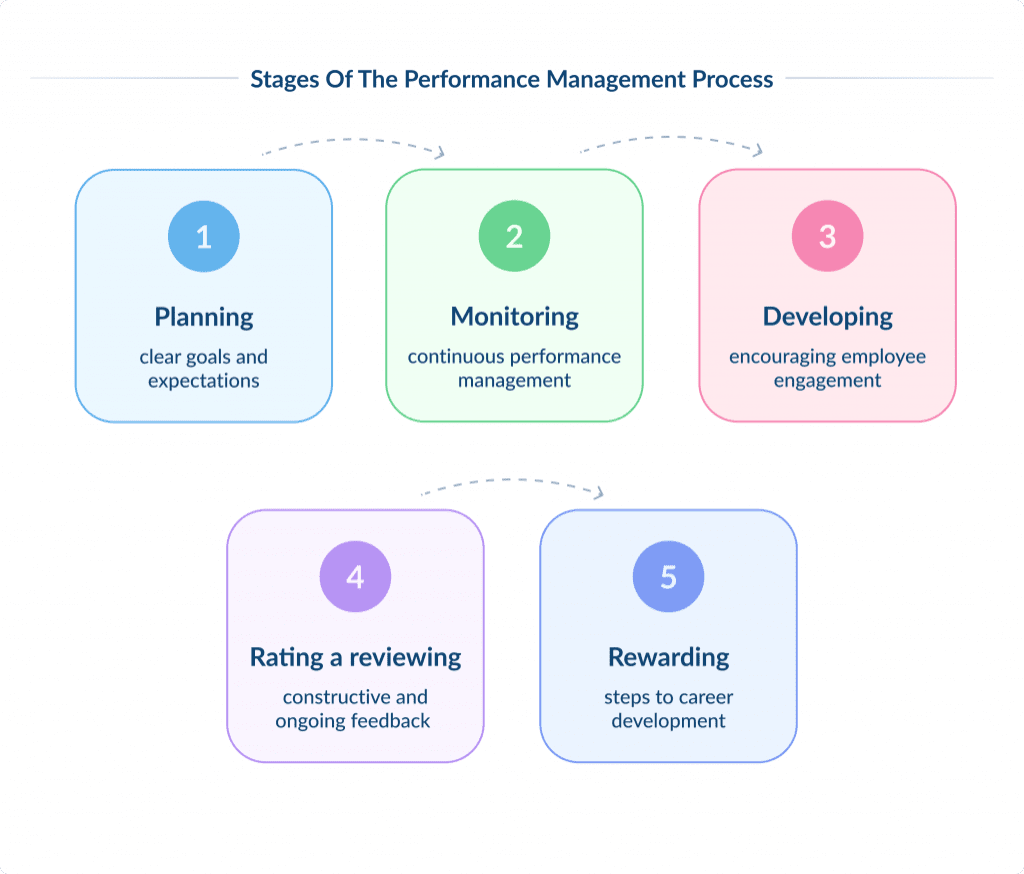
Performance Management Software
As we’ve already mentioned, performance management software is designed to streamline and improve goal setting, performance reviews, and career development conversations.
Here are some must-have features to help you choose the best performance management system for your organization:
| Feature | Why It’s Needed | Example |
|---|---|---|
| Goal setting & tracking | Helps employees set clear objectives and measure progress | OKRs (Objectives & Key Results) tracking tools |
| Continuous and timely feedback | Real-time coaching instead of annual reviews | 360-degree feedback tools |
| Performance evaluations | Streamlines evaluations and provides structured feedback | Automated performance review templates |
| Employee development plans | Enhanced career growth through learning and skill-building | Personalized training recommendations |
| Analytics & reporting | Data-driven insights into employee performance | Dashboards with performance trends and reports |
| Recognition & rewards | Acknowledging achievements boosts engagement | Peer-to-peer recognition and bonus systems |
| Integration with HR systems | For a seamless workflow across HR tools | Syncing with payroll and employee databases |
| Customizable performance metrics | Adapts to different roles, industries, and company needs | Configurable rating scales and review questions |
| Self-assessment tools | Employees are encouraged to reflect on their own progress | Self-review surveys and competency assessments |
| Mobile accessibility | Employees and managers can access tools on the go | Mobile app for real-time feedback and check-ins |
Fuel your startup's growth with tailored mobile apps.
Popular Performance Management Software Tools
Here are some widely used performance management software solutions:
Lattice
Lattice is a cloud-based performance management and employee engagement platform that helps companies manage performance and keep employees engaged.
It makes goal setting, feedback, and performance reviews easier as each of these functionalities is in one place. For example, instead of waiting for annual reviews, teams can have ongoing conversations about growth, recognition, and career development.
Key benefits:
- Focuses on goal setting, feedback, and performance reviews.
- Offers 360-degree feedback and employee engagement tools.
15Five
15Five helps companies build a culture of continuous feedback and employee growth.
It allows teams to set goals, track progress, give and receive feedback, and run performance reviews —all in a simple, user-friendly way.
Just like Lattice, 15Five encourages ongoing check-ins to keep employees engaged and aligned with organizational performance objectives instead of relying on traditional annual reviews.
Key benefits:
- Emphasizes continuous feedback and weekly check-ins.
- Includes OKR (Objectives and Key Results) tracking.
BambooHR
BambooHR is an all-in-one HR software solution designed to simplify and streamline employee management for small and medium-sized businesses.
It offers features like performance management, time tracking, employee records, and reporting, all in a user-friendly interface.
BambooHR helps companies manage everything from hiring to performance reviews, employee engagement, and compensation tracking.
Key benefits:
- Combines performance management with HRIS functionalities.
- Features performance reviews, goal tracking, and employee recognition.
Workday
Workday is a comprehensive cloud-based software solution for human resources, finance, and planning.
It helps organizations manage everything from recruitment and talent management to payroll, performance, and financial planning.
Workday provides real-time insights and analytics that make it easier for businesses to make data-driven decisions.
Its user-friendly interface and powerful automation help companies of all sizes streamline administrative tasks and enhance overall efficiency.
Key benefits:
- Integrates performance management with talent management and HR systems.
- Provides advanced analytics and reporting.
Namely
Namely is an all-in-one HR platform designed for mid-sized companies.
The solution helps businesses manage everything from payroll and benefits to performance reviews and time tracking.
It offers tools to streamline HR processes, improve employee engagement, and ensure compliance, all through an intuitive, user-friendly interface.
Key benefits:
- Offers performance reviews, goal tracking, and employee development.
- Includes HR and payroll integration.
PerformYard
PerformYard is a performance management system that helps companies simplify and improve the way they manage employee performance.
It makes setting goals, giving feedback, and running performance reviews easier and more organized.
With tools that track progress and support employee development, PerformYard helps create clear paths for growth.
The platform focuses on making communication between managers and employees smoother, so everyone stays aligned and motivated.
Key benefits:
- Customizable performance review templates and goal tracking.
- Focuses on simplicity and ease of use.
Cornerstone OnDemand
Cornerstone OnDemand is a cloud-based talent management platform that helps organizations manage employee learning, performance, recruitment, and development.
It offers a variety of tools to support training, career development, and performance reviews, with a focus on improving employee skills and engagement.
Cornerstone OnDemand makes it easier for companies to align their workforce with business goals, while helping employees grow and reach their full potential.
The platform is designed to foster a culture of continuous learning and development across organizations of all sizes.
Key benefits:
- Combines performance management with learning and development.
- Features 360-degree feedback and succession planning.
SAP SuccessFactors
SAP SuccessFactors is a cloud-based human resources software platform that helps organizations manage all aspects of talent management, from recruitment and onboarding to performance, learning, and employee engagement.
It offers tools to streamline HR processes, improve workforce planning, and enhance employee development.
With data-driven insights and customizable features, SAP SuccessFactors helps businesses make smarter decisions about their people while creating a more engaging and productive work environment.
It’s designed to align talent strategies with business goals, making it easier for companies to attract, develop, and retain top talent.
Key benefits:
- Comprehensive performance and talent management suite.
- Includes goal alignment, continuous feedback, and analytics.
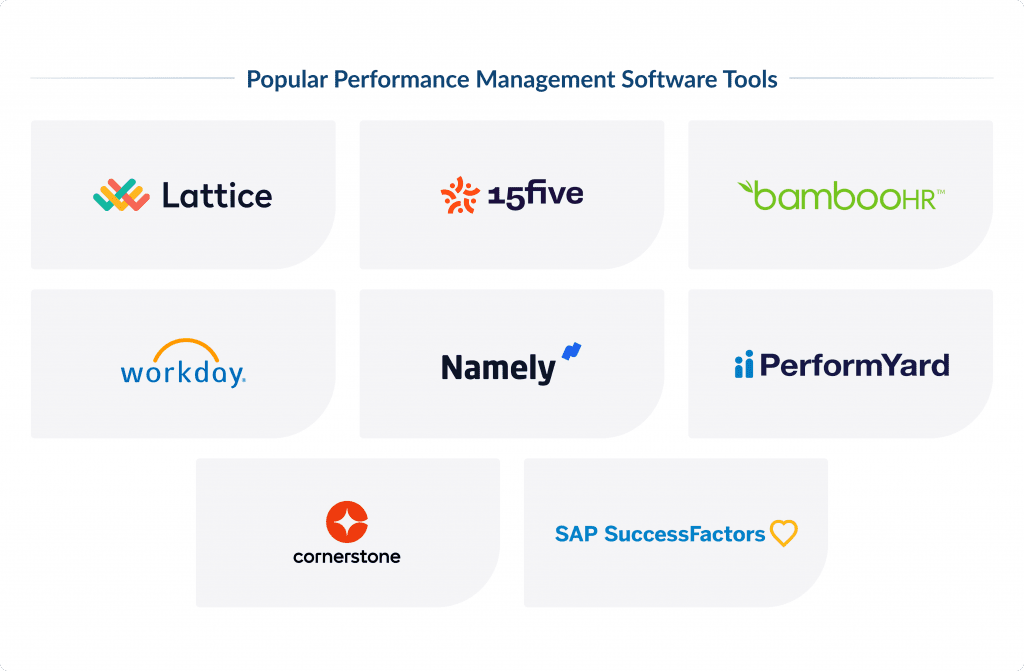
How to Choose the Right Performance Management System
There are many human resource management systems available, and the ones we have explored here are just a small part of them.
So, how do you choose the performance management software that incorporates all the performance management best practices you need?
Here are a few important factors to consider when choosing a performance management tool for your company:
Organizational goals
First, you need to understand what you really want to achieve with the system.
Are you looking to improve how feedback flows within the team?
Do you need to automate reviews or track employee performance and growth over time?
Know your organizational goals before you make a decision, as it helps narrow down the right features.
Ease of use
Choose a user-friendly platform that employees and managers will adopt easily.
If the platform is too complicated, employees and managers will be less likely to use it.
A user-friendly tool means managers can easily give feedback, track goals, and review performance without needing a long training period.
Integration capabilities
Ensure the software integrates with your existing HR systems and tools.
Think about the tools you’re already using.
If you already have software for payroll, recruiting, or scheduling, it’s important that the new performance management system can work seamlessly with these tools.
That way, all your HR data is in one place, and there is no need to input information manually.
Customization
Look for software that allows customization to fit your organization’s processes and workflows.
Every company is different, and your performance management system should reflect that.
Look for a system that can adapt to your processes — whether that’s adding custom review questions, adjusting goal-setting templates, or setting specific milestones that match your unique business needs.
Scalability
Select a solution that can grow with your organization.
A tool that works well with just 10 employees might not cut it when you hit 100.
Scalability means the platform can handle more users, more departments, and more data without losing effectiveness.
You might start with a system that’s simple and affordable for a small team.
But when you expand, you’ll need a tool that can handle multiple teams across different locations and still offer reporting tools that make sense for larger organizations.
Cost
Evaluate pricing plans to see if the software you choose fits your budget.
A high-priced system might offer tons of features, but it’s important to make sure those features match your goals.
You also don’t want to just go for the cheapest option. Find the system that meets your needs and is within your budget.
For example, if you are a growing startup, you might lean toward a budget-friendly system with just the essential features, like feedback loops and basic reviews. Then, as you grow, you can upgrade or even go for custom HR software development.
On the other hand, a large corporation might invest in a more robust platform that handles complex reviews, goal tracking, and performance analytics.
Customer support
Choose a vendor with reliable customer support and training resources. No one wants to get stuck with a system they don’t know how to use or fix.
You want to make sure the company behind the tool offers good support and resources, whether it’s live chat, training, or a knowledge base to help your HR team.
Hopefully, these tips will help you choose the performance management system that will fit your needs perfectly.
However, there might be cases when none of the available performance management tools suit your goals.
In this case, you might consider custom performance management system development. 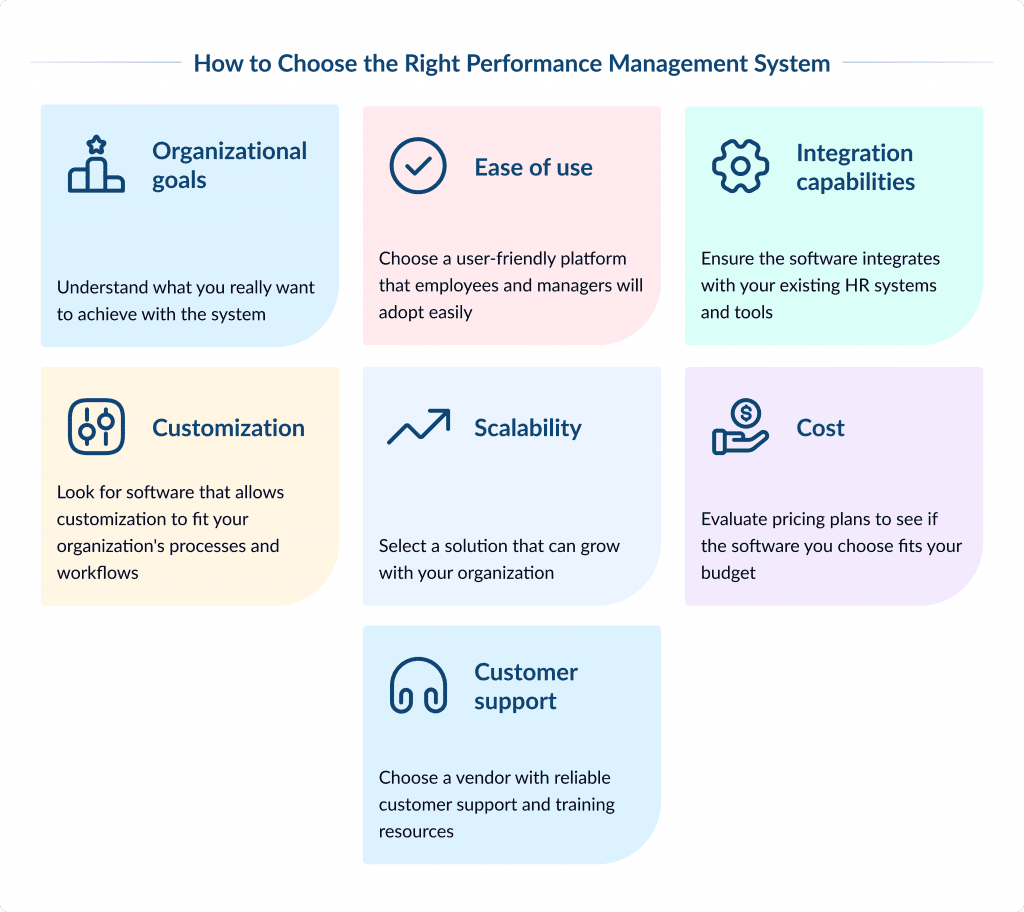
When Do You Need A Custom-Made Performance Management System?
If you’re considering a custom performance management system, chances are the existing options just don’t fit your needs. Maybe your team has unique ways of measuring performance, or the software you’ve tried feels clunky and doesn’t integrate well with your other tools.
A custom-built system gives you full control — you get exactly what you need, nothing you don’t, and it scales as your company grows.
Think about it this way: if you run a creative agency, standard HR software might focus too much on numbers when what really matters is client feedback and team collaboration.
Or, if you’re in healthcare, you might need to track patient outcomes and compliance, not just generic productivity stats. A custom solution ensures your system actually reflects how your team works.
It’s also about making performance management processes easier.
If your employees are stuck juggling multiple platforms for performance tracking, employee goal tracking, and project management, a custom system can bring it all into one place.
Plus, you’ll have control over data security and privacy, which is a big deal in industries with strict regulations.
At the end of the day, if your current tools are causing more frustration than they’re solving, a custom solution could be the smarter investment.
Let’s chat about what would work best for your team.






